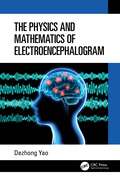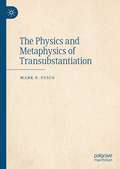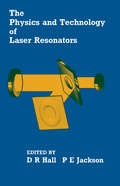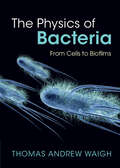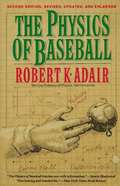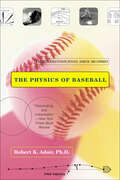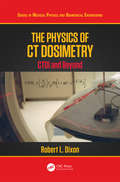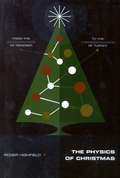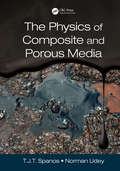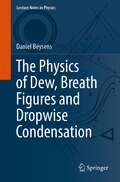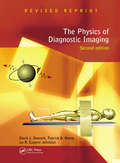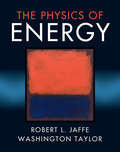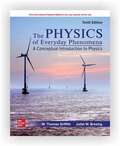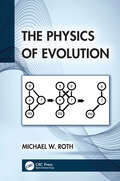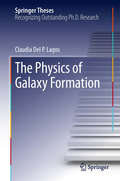- Table View
- List View
The Physics and Mathematics of Electroencephalogram
by Dezhong YaoThis book focuses on a systematic introduction to the knowledge of mathematics and physics of electroencephalogram (EEG) and discusses an in-depth application of EEG and the development of new methods and technologies for mining and analyzing EEG.The Physics and Mathematics of Electroencephalogram offers a systematic overview of the technology for brain function and disease. It covers six parts: background knowledge of EEG, EEG forward problems, high-resolution EEG imaging, EEG inverse problems, EEG reference electrode, and EEG cloud platform. The author reviews the critical technologies in brain function and disease, such as EEG sourcing, EEG imaging, and EEG reference electrode standardization technique. The book’s aim is to clarify the mechanism of EEG from the perspective of physics, mathematics, and engineering science to help multidisciplinary readers better understand and use EEG information more effectively.This book can be used as reference for researchers in the fields of neuroengineering, cognitive neuroscience, neurology, psychiatry, applied mathematics, and brain-like intelligence.
The Physics and Metaphysics of Transubstantiation
by Mark P. FuscoIn this book, Mark P. Fusco offers a historical, philosophical and theological review and appraisal of current research into quantum, post-modern, atheistic, mathematical, and philosophical theories that engage our interpretation of Hans Urs von Balthasar and Ferdinand Ulrich’s accounts of Ur-Kenosis. This cross-disciplinary approach inspires a new speculative metaphysical theory based on the representation of being as a holo-somatic ontology. Holocryptic metaphysics gives us a novel interpretation of transubstantiation as it is founded on the findings of quantum mechanical theory. The quantum object and black hole’s properties present a new way to explain physical matter based on its holographic identity. This scientific theory for representing physical matter’s identity is recognized, for example, in the symmetry existing between a subatomic particle and its orbital shell, a single particle’s identity in relationship to its thermodynamic system, Hawking radiation, and black hole entropy. Further, the properties of quantum non-locality and teleportation signpost a new way to understand the Eternal Logos’ relationship to Jesus Christ and the Eucharist.
The Physics and Psychophysics of Music
by Juan G. RoedererThis introductory text deals with the physical systems and biological processes that intervene in what we broadly call "music." It analyzes what physical properties of sound patterns are associated with what psychological sensations of music, and describes how these sound patterns are actually produced in musical instruments, how they propagate through the environment, and how they are detected by the ear and interpreted in the brain. Without using complicated mathematics, the author weaves a close mesh between the disciplines of acoustics, psychophysics, and neurobiology, offering an integral picture of not only the science of music, but also the "music of science", that is, the beauty and excitement of scientific research, reasoning and understanding. This text should be accessible to undergraduate-level students, whether from science, arts or engineering schools, but it should also be useful to professional musicians, physics educators, acoustical engineers and neuroscientists. The fourth edition incorporates recent research on tone generation in musical instruments and latest findings in brain science.
The Physics and Technology of Laser Resonators
by Denis Hall P.E. JacksonComprehensive yet concise, The Physics and Technology of Laser Resonators presents both the fundamentals and latest developments in laser resonator technology, including specific case studies. The book covers various types of resonators, including unstable, ring laser, and multifold laser. It also discusses numerical resonator calculations and laser beam analysis. This reference will be of value and interest both to newcomers to the field and to professional engineers wishing to update their knowledge.
The Physics of Advanced Optical Materials: Tellurite Glasses
by Raouf El-MallawanyThis book focuses on advanced optical properties and applications of tellurite glasses and tellurite glasses doped with rare-earth nanoparticles. The initial chapter presents the current state of the art in tellurite glass development, focusing on those compositions doped with nanoparticles based on rare-earth elements such as neodymium and erbium. The book then discusses various linear and nonlinear optical properties (e.g., refractive index, absorption, optical susceptibility) of these glasses in the visible and ultraviolet spectral regions. Finally, it looks at a selection of recent technological applications of doped tellurite glasses, such as highly efficient laser glass, novel temperature sensors, and advanced optical fiber material. Featuring comprehensive and up-to-date data sets, along with a topical discussion of promising new areas of application, this book is particularly suitable for researchers and industry professionals working in the field of glass manufacturing for optics and laser applications.
The Physics of Bacteria: From Cells to Biofilms
by Thomas Andrew WaighBacteria are the most ubiquitous life-forms on Earth, and are studied extensively to gain insight into their function and understand how they interact with their environment. In recent years, bacterial biophysics has added a new dimension to this research by using the tools of physics to investigate the quantitative principles that underpin these cellular systems. This book provides a modern and cohesive introduction to bacterial biophysics, with a focus on biofilms, slimes and capsules. In the first of three sections, key techniques and models from the physical sciences that can be applied to bacterial problems are presented. Section 2 then provides a bacterial microbiology primer for physical scientists and an examination of single-cell phenomena. The final section explores interacting bacteria and biofilms from a physical perspective. Ideal for physics graduates interested in this important field, this book is also relevant for researchers in physical chemistry, bioengineering, mathematics and microbiology.
The Physics of Baseball
by Robert K. AdairScads of interesting facts about baseball as well as the physical laws of the game.
The Physics of Baseball: Third Edition, Revised, Updated, and Expanded
by Robert K. AdairA “fascinating and irresistible” blend of science and sports that reveals what a baseball (or bat, or player) in motion does—and why (The New York Times Book Review).How fast can a batted ball go? What effect do stitch patterns have on wind resistance? How far does a curveball break? Who reaches first base faster after a bunt, a right- or left-handed batter? The answers are often surprising—and always illuminating.This newly revised third edition considers recent developments in the science of sport such as the neurophysiology of batting, bat vibration, and the character of the “sweet spot.” Faster pitchers, longer hitters, and enclosed stadiums also get a good, hard scientific look to determine their effects on the game.Filled with anecdotes about famous players and incidents, The Physics of Baseball provides fans with fascinating insights into America’s favorite pastime.“Delivers scads of interesting facts.” —The Wall Street Journal
The Physics of Basketball
by John J. FontanellaDrain three pointers, slam dunk easily, and sink that buzzer beater from half court with the help of simple science. Your coach, physicist John J. Fontanella, shows how you can improve your game if you take advice from Isaac Newton. As you read, relive some of the great moments in the game—this time with a scientist and diehard basketball fan as your color analyst. Find out why you ought to put spin on the ball. Get tips on how to improve your free throw and increase your percentage from the charity stripe. You’ll even learn how to shatter the backboard, if that’s something you’ve always dreamed of doing. With photographs and simple high school formulas, physics professor Fontanella—who played in college against Pittsburgh and Syracuse—reveals the key pieces of physics that underscore basketball. He covers almost every aspect of the game, weaving in stories from games he’s played and games he’s seen, and tales from basketball history and folklore. Physics comes alive as you see how Kobe Bryant, Wilt "the Stilt" Chamberlain, Michael Jordan, Becky Hammon, and J. J. Reddick do naturally the things that Isaac Newton says they should.
The Physics of CT Dosimetry: CTDI and Beyond (Series in Medical Physics and Biomedical Engineering)
by Robert DixonThis book explores the physics of CT dosimetry and provides practical guidance on best practice for medical researchers and practitioners. A rigorous description of the basic physics of CT dosimetry is presented and illustrates flaws of the current methodology. It also contains helpful (and rigorous) shortcuts to reduce the measurement workload for medical physicists. The mathematical rigor is accompanied by easily-understood physical explanations and numerous illustrative figures. <P><P>Features: <li>Authored by a recognised expert in the field and award-winning teacher <li>Includes derivations for tube current modulation and variable pitch as well as stationary table techniques <li>Explores abnormalities present in dose-tracking software based on CTDI and presents methods to correct them
The Physics of Christianity
by Frank J. TiplerA highly respected physicist demonstrates that the essential beliefs of Christianity are wholly consistent with the laws of physics. Frank Tipler takes an exciting new approach to the age-old dispute about the relationship between science and religion in The Physics of Christianity. In reviewing centuries of writings and discussions, Tipler realized that in all the debate about science versus religion, there was no serious scientific research into central Christian claims and beliefs.
The Physics of Christmas: From the Aerodynamics of Reindeer to the Thermodynamics of Turkey
by Roger HighfieldCan reindeer fly? Why is Santa Claus fat? Was the Star of Bethlehem really a comet? Could scientists clone the perfect Christmas tree? What could we do to guarantee a white Christmas every year? Why is Rudolph's nose red? How does Santa manage to deliver presents to an estimated 842 million households in a single night? These are among the questions explored in an irresistibly witty book that illuminates the cherished rituals, legends, and icons of Christmas from a unique and fascinating perspective: science.
The Physics of Composite and Porous Media
by T. J. Spanos Norman UdeyBuilding on the success of T.J.T. Spanos's previous book The Thermophysics of Porous Media, The Physics of Composite and Porous Media explains non-linear field theory that describes how physical processes occur in the earth. It describes physical processes associated with the interaction of the various phases at the macroscale (the scale at which continuum equations are established) and how these interactions give rise to additional physical processes at the megascale (the scale orders of magnitude larger at which a continuum description may once again be established). Details are also given on how experimental, numerical and theoretical work on this subject fits together. This book will be of interest to graduate students and academic researchers working on understanding the physical process in the earth, in addition to those working in the oil and hydrogeology industries.
The Physics of Dark Shadows: Time Travel, ESP, and the Laboratory
by Frank BorzellieriIn "The Physics of Dark Shadows," Frank Borzellieri reveals for the first time that so many of the bizarre, supposedly supernatural occurrences on Dark Shadows actually have their bases in scientific reality. He points out in fascinating detail how time travel in no way defies the laws of physics and is irrefutably proven through Einstein's theories. In fact, not only can time travel actually happen, it already has happened! These concepts, including traveling to the past and future, as well as parallel time, have a scientific foundation and are studied vigorously in the world's leading institutions and scientific journals. While the time traveling methods of Professor Stokes. Barnabas Collins, and Julia Hoffman may differ from Einstein's wormholes and light speed, the basic notions are very real. Moreover, the extrasensory perception utilized by Angelique and other Dark Shadows characters also has a long and distinguished history of respectable scientific study. Mixing the theories of Einstein, Stephen Hawking, and the world's leading physicists with countless examples from the storylines of Dark Shadows, Frank Borzellieri writes in a manner both scholarly yet enjoyable for the average Dark Shadows fan.
The Physics of Deformation and Fracture of Polymers
by A. S. ArgonDemonstrating through examples, this book presents a mechanism-based perspective on the broad range of deformation and fracture response of solid polymers. It draws on the results of probing experiments and considers the similar mechanical responses of amorphous metals and inorganic compounds to develop advanced methodology for generating more precise forms of modelling. This, in turn, provides a better fundamental understanding of deformation and fracture phenomena in solid polymers. Such mechanism-based constitutive response forms have far-reaching application potential in the prediction of structural responses and in tailoring special microstructures for tough behaviour. Moreover, they can guide the development of computational codes for deformation processing of polymers at any level. Applications are wide-ranging, from large strain industrial deformation texturing to production of precision micro-fluidic devices, making this book of interest to both advanced graduate students and to practising professionals.
The Physics of Dew, Breath Figures and Dropwise Condensation (Lecture Notes in Physics #994)
by Daniel BeysensIn this book, the author focuses on the physics behind dew, breaths figures, and dropwise condensation phenomena to introduce scientists, engineers and students to the many original processes involved in condensation. Consisting of 15 Chapters, 18 Appendices and over 500 references, the reader learns the needed theoretical backgrounds and formulae to understand the complexity of dropwise condensation. Heat and mass transfer, nucleation and growth on various substrates are considered (solid, liquid, plastic, undergoing phase change or micro-patterned substrates). The particular role of thermal or geometrical discontinuities where growth can be enhanced or reduced, dynamical aspects of self-diffusion, problems related to drop collection by gravity and the optics of dropwise condensation are all discussed. Although the content mainly deals with condensation from humid air, it can readily be generalized to condensation of any substance. The specificities of pure vapor condensation (e.g. steam) are also examined. Numerous images are provided within the text to illustrate the physics. This book is meant for those studying or researching dew and dropwise condensation, but also for individuals wishing to develop their knowledge on the subject.
The Physics of Diagnostic Imaging
by David Dowsett Patrick A Kenny R Eugene JohnstonOver recent years there has been a vast expansion in the variety of imaging techniques available, and developments in machine specifications continue apace.
The Physics of Energy
by Robert L. Jaffe Washington TaylorThe Physics of Energy provides a comprehensive and systematic introduction to the scientific principles governing energy sources, uses, and systems. This definitive textbook traces the flow of energy from sources such as solar power, nuclear power, wind power, water power, and fossil fuels through its transformation in devices such as heat engines and electrical generators, to its uses including transportation, heating, cooling, and other applications. The flow of energy through the Earth's atmosphere and oceans, and systems issues including storage, electric grids, and efficiency and conservation are presented in a scientific context along with topics such as radiation from nuclear power and climate change from the use of fossil fuels. Students, scientists, engineers, energy industry professionals, and concerned citizens with some mathematical and scientific background who wish to understand energy systems and issues quantitatively will find this textbook of great interest.
The Physics of Ettore Majorana
by Salvatore EspositoThrough just a handful of papers, Ettore Majorana left an indelible mark in the fields of physics, mathematics, computer science and even economics before his mysterious disappearance in 1938. It is only now that the importance of Majorana's work is being realised: Majorana fermions are intensely studied today, and his work on neutrino physics has provided possible explanations for the existence of dark matter. In this unique volume, Salvatore Esposito explores not only Majorana's known papers but, even more interestingly, unveils his unpublished works as well. These include powerful methods and results, ranging from the atomic two-centre problem, the Thomas-Fermi model and ferromagnetism to quasi-stationary states, n-component relativistic wave equations and quantum scalar electrodynamics. Featuring biographical notes and contributions from leading experts Evgeny Akhmedov and Frank Wilczek, this fascinating book will captivate graduate students and researchers interested in frontier science as well as in the history of science.
The Physics of Everyday Phenomena: A Conceptual Introduction to Physics
by W. Thomas Griffith Juliet Wain BrosingThe Physics of Everyday Phenomena introduces students to the basic concepts of physics, using examples of common occurrences in everyday life. Intended for use in a one-semester or two-semester course in conceptual physics, this book is written in a narrative style, frequently using questions designed to draw the reader into a dialogue about the ideas of physics. This inclusive style allows the book to be used by anyone interested in exploring the nature of physics and explanations of everyday physical phenomena.
The Physics of Everyday Phenomena: A Conceptual Introduction to Physics, Sixth Edition
by W. Thomas Griffith Juliet W. BrosingThe Physics of Everyday Phenomena, Sixth Edition, introduces students to the basic concepts of physics using examples of common occurrences. Intended for use in a one-semester or two-semester course in conceptual physics, this book is written in a narrative style, frequently using questions designed to draw the reader into a dialogue about the ideas of physics.
The Physics of Everyday Things: The Extraordinary Science Behind an Ordinary Day
by James KakaliosPhysics professor, bestselling author, and dynamic storyteller James Kakalios reveals the mind-bending science behind the seemingly basic things that keep our daily lives running, from our smart phones and digital “clouds” to x-ray machines and hybrid vehicles. Most of us are clueless when it comes to the physics that makes our modern world so convenient. What’s the simple science behind motion sensors, touch screens, and toasters? How do we glide through tolls using an E-Z Pass, or find our way to new places using GPS? In The Physics of Everyday Things, James Kakalios takes us on an amazing journey into the subatomic marvels that underlie so much of what we use and take for granted. Breaking down the world of things into a single day, Kakalios engages our curiosity about how our refrigerators keep food cool, how a plane manages to remain airborne, and how our wrist fitness monitors keep track of our steps. Each explanation is coupled with a story revealing the interplay of the astonishing invisible forces that surround us. Through this “narrative physics,” The Physics of Everyday Things demonstrates that—far from the abstractions conjured by terms like the Higgs Boson, black holes, and gravity waves—sophisticated science is also quite practical. With his signature clarity and inventiveness, Kakalios ignites our imaginations and enthralls us with the principles that make up our lives.
The Physics of Everyday Things: The Extraordinary Science Behind an Ordinary Day
by James KakaliosMost of us are clueless when it comes to the physics that makes our modern world so convenient. What's the simple science behind motion sensors, touch screens and toasters? How do we enter our offices using touch-on passes or find our way to new places using GPS? In The Physics of Everyday Things, James Kakalios takes us on an amazing journey into the subatomic marvels that underlie so much of what we use and take for granted.Breaking down the world of things into a single day, Kakalios engages our curiosity about how our refrigerators keep food cool, how a plane manages to remain airborne, and how our wrist fitness monitors keep track of our steps. Each explanation is coupled with a story revealing the interplay of the astonishing invisible forces that surround us. Through this 'narrative physics' The Physics of Everyday Things demonstrates that - far from the abstractions conjured by terms like the Higgs boson, black holes and gravity waves - sophisticated science is also quite practical. With his signature clarity and inventiveness, Kakalios ignites our imaginations and enthralls us with the principles that make up our lives.
The Physics of Evolution
by Michael W. RothThis book provides an introduction to the significant role of physics in evolution, based on the ideas of matter and energy resource flow, organism self-copying, and ecological change. The text employs these ideas to create quantitative models for important evolutionary processes.Many fields of science and engineering have come up against the problem of complex design—when details become so numerous that computer power alone cannot make progress. Nature solved the complex-design problem using evolution, yet how it did so has been a mystery. Both laboratory experiments and computer-simulation attempts eventually stopped evolving. Something more than Darwin’s ideas of heredity, variation, and selection was needed. The solution is that there is a fourth element to evolution: ecological change. When a new variation is selected, this can change the ecology, and the new ecology can create new opportunities for even more new variations to be selected. Through this endless cycle, complexity can grow automatically. This book uses the physics of resource flow to describe this process in detail, developing quantitative models for many evolutionary processes, including selection, multicellularity, coevolution, sexual reproduction, and the Serengeti Rules. The text demonstrates that these models are in conceptual agreement with numerous examples of biological phenomena, and reveals, through physics, how complex design can arise naturally. This will serve as a key text on the part physics plays in evolution, and will be of great interest to students at the university level and above studying biophysics, physics, systems biology, and related fields.
The Physics of Galaxy Formation
by Claudia Del P. LagosThis thesis addresses two of the central processes which underpin the formation of galaxies: the formation of stars and the injection of energy into the interstellar medium from supernovae, called feedback. In her work Claudia Lagos has completely overhauled the treatment of these processes in simulations of galaxy formation. Her thesis makes two major breakthroughs, and represents the first major steps forward in these areas in more than a decade. Her work has enabled, for the first time, predictions to be made which can be compared against new observations which probe the neutral gas content of galaxies, opening up a completely novel way to constrain the models. The treatment of feedback from supernovae, and how this removes material from the interstellar medium, is also likely to have a lasting impact on the field. Claudia Lagos Ph. D. thesis was nominated by the Institute for Computational Cosmology at Durham University as an outstanding Ph. D. thesis 2012.
